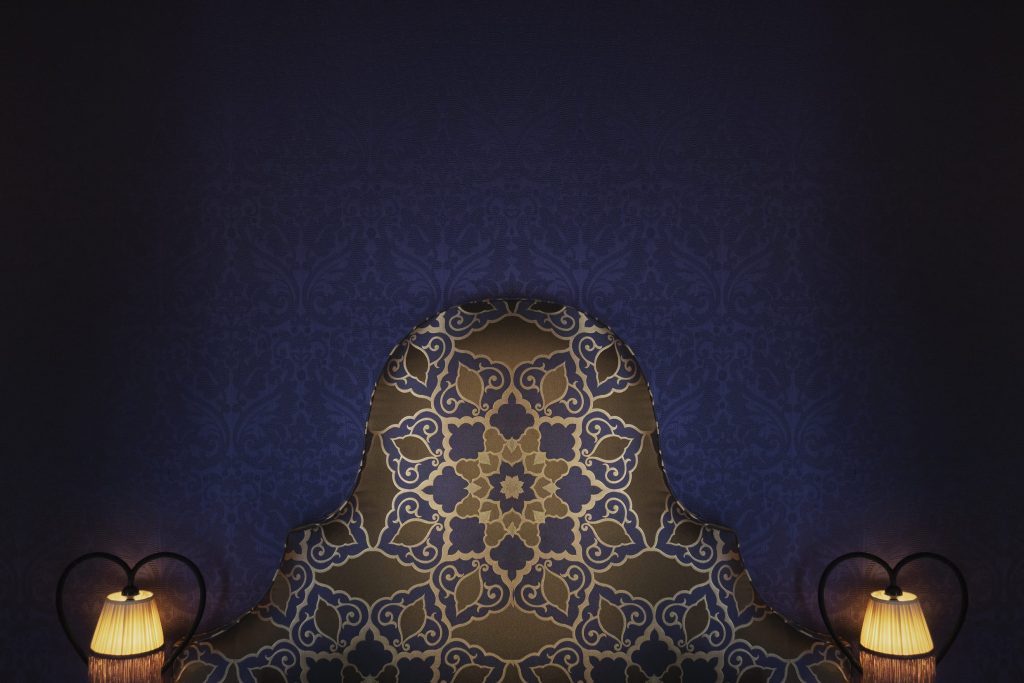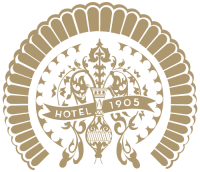
INDIAN INSPIRATION
Starting from the late 16th century, with increased trade between East and West, printed fabrics known as “Indiennes” gained tremendous popularity in Europe. Used for clothing and hangings, these lightweight fabrics are recognizable by their floral motifs and warm colors.
You’ll find this inspiration in the Douchka, Appolonie, and Liane de Pougy I rooms and suites
Douchka
INDIAN INSPIRATION
He possesses caressing blue eyes, a face of childlike sweetness, and a silky beard: the young count does not regret having entered the doors of Maison Souquet, one of the most sought-after pleasure places in the capital. Douchka, his chosen one for the night, sensual but seemingly unaware, simultaneously naive and mischievous, perfectly embodies his feminine ideal. He doesn’t yet suspect that he will passionately succumb to this flirtatious woman with an exhilarating allure, to the great misfortune… of his wallet.
Passionate about balls, cabarets, and music halls, Douchka takes him daily to dressmakers, milliners, and jewelers to be adorned like a princess when, come evening, she parades on his arm at the Folies-Bergère or the Moulin Rouge. On December 9, 1896, the couple finds themselves at the Théâtre de la Renaissance amidst fifteen hundred people when the celebrated Sarah Bernhardt receives an ovation from the most prominent figures in arts and letters. Enthusiastic, Douchka then has only one thing in mind: to become an actress. The count is indebted? It’s high time for the ambitious woman to look elsewhere…
Apollonie
INDIAN INSPIRATION
An illegitimate child, the charming Aglaé Savatier quickly understands the necessity of finding herself a protector. This would be the art collector Alfred Mosselman. Aglaé, who preferred to rename herself Apollonie, then hosts numerous artists in her salon on Rue Frochot. There are musicians such as Berlioz, painters and sculptors like Meissonnier, Vidal, Jalabert, Courbet, writers including Gautier, Dumas father, Flaubert, the Goncourt brothers, and poets such as Musset, Nerval, Baudelaire, who make her their muse or model. Enchanted by the one who inspires certain poems in ‘The Flowers of Evil’, Baudelaire becomes her secret lover. All have great respect for this free, intelligent, and audacious woman who, unlike other women of the demimonde, seeks more to learn than to please.
Before leaving her for a younger woman, Mosselman, proud to show off to everyone the irresistible curves of his mistress, had her sculpted by Auguste Clésinger: arched back and lascivious pose, Femme piquée par un serpent caused an immense scandal at the Salon of 1847 but immortalized the beautiful Apollonie forever.
LIANE DE POUGY I
INDIAN INSPIRATION
“The most beautiful woman of the century,” this is how the writer Edmond de Goncourt describes her—a courtesan who collects both pearls and lovers, poses for the painter Antonio de la Gandara with whom she has an affair, yet this doesn’t prevent her from also loving women.
Unlike most “grands horizontales” of the Belle Epoque who come from modest backgrounds, Liane de Pougy comes from a very respectable family. Born Anne-Marie Chassaigne, the tall brunette with an androgynous physique and a slender silhouette receives an excellent education before marrying a young military man at the age of sixteen. However, for a fiery temperament like hers, the constraints of marriage soon become too heavy to bear: Anne-Marie quickly abandons her husband and son to enter a house of pleasure in Paris under the name Liane de Pougy. She swiftly climbs the ranks of gallantry, becoming a dancer at the Folies-Bergères, then a mime at the Olympia. The ostentatious rivalry maintained with La Belle Otero solidifies their fame as queens of Parisian life during the Belle Epoque.

